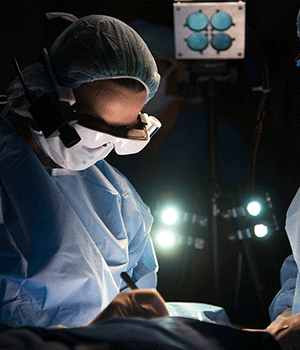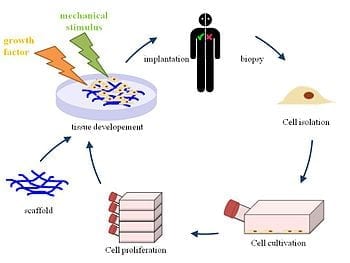
High-tech glasses developed at Washington University School of Medicine in St. Louis may help surgeons visualize cancer cells, which glow blue when viewed through the eyewear.
The wearable technology, so new it’s yet unnamed, was used during surgery for the first time today at Alvin J. Siteman Cancer Center at Barnes-Jewish Hospital and Washington University School of Medicine.
Cancer cells are notoriously difficult to see, even under high-powered magnification. The glasses are designed to make it easier for surgeons to distinguish cancer cells from healthy cells, helping to ensure that no stray tumor cells are left behind during surgery.
“We’re in the early stages of this technology, and more development and testing will be done, but we’re certainly encouraged by the potential benefits to patients,” said breast surgeon Julie Margenthaler, MD, an associate professor of surgery at Washington University, who performed today’s operation. “Imagine what it would mean if these glasses eliminated the need for follow-up surgery and the associated pain, inconvenience and anxiety.”
Current standard of care requires surgeons to remove the tumor and some neighboring tissue that may or may not include cancer cells. The samples are sent to a pathology lab and viewed under a microscope. If cancer cells are found in neighboring tissue, a second surgery often is recommended to remove additional tissue that also is checked for the presence of cancer.
The glasses could reduce the need for additional surgical procedures and subsequent stress on patients, as well as time and expense.
Margenthaler said about 20 to 25 percent of breast cancer patients who have lumps removed require a second surgery because current technology doesn’t adequately show the extent of the disease during the first operation.
“Our hope is that this new technology will reduce or ideally eliminate the need for a second surgery,” she said.
The technology, developed by a team led by Samuel Achilefu, PhD, professor of radiology and biomedical engineering at Washington University, incorporates custom video technology, a head-mounted display and a targeted molecular agent that attaches to cancer cells, making them glow when viewed with the glasses.
The Latest on: Seeing cancer
[google_news title=”” keyword=”Seeing cancer” num_posts=”10″ blurb_length=”0″ show_thumb=”left”]
via Google News
The Latest on: Seeing cancer
- Pittsburgh-area cancer patient granted wish of seeing Pittsburgh Pirates play at PNC Parkon April 29, 2024 at 3:49 pm
"We do this because we love geriatrics and we have made geriatrics our life's work, and it is just so important to give back to them." ...
- Science & Medicine: Revolutionizing prostate cancer treatmenton April 29, 2024 at 2:26 pm
Prostate cancer is the most common cancer diagnosed in men, and the five year survival rate is 97%.
- Temple Health now screening for both lung cancer and COPD with one quick teston April 29, 2024 at 11:26 am
Long-time smokers and former smokers are eligible to be screened every year for lung cancer. But Temple Health says adding a simple test could tell doctors so much more.
- Advanced Stage Colorectal Cancer In Young Adults Is A Growing Crisison April 29, 2024 at 11:17 am
Colorectal cancer in young adults is occurring at alarming rates. Here are steps to take to prevent this disease from affecting you and loved ones.
- Dear Abby: Breast cancer affects far fewer men than women, but it is serious, nonethelesson April 29, 2024 at 9:00 am
I was first diagnosed in 2008, with a recurrence in 2018, and I have been amazed by the number of people I have spoken to who don’t realize the fact it exists.
- Testicular Cancer: Doctor Explains Why It Is Important To See Beyond Embarrassmenton April 29, 2024 at 2:02 am
Testicular cancer is seen as an embarrassment by many because of which signs are overlooked Read on to know why raising awareness is important ...
- Mum’s warning after son’s cancer detected through tiny unusual glow in his eyeon April 27, 2024 at 2:01 am
Mum’s warning after son’s cancer detected through tiny unusual glow in his eye - Experts say the typical signs of retinoblastoma include a white glow which may only appear in certain lights or a squin ...
- In a first, scientists use new tech to see inside cancer cellson April 26, 2024 at 6:20 am
This technique might also help doctors understand how some cancer cells resist radiation treatment, among other benefits.
- Scientists Can Now See Inside a Single Cancer Cellon April 25, 2024 at 5:00 pm
A team in the UK has found a new window into cancer, thanks to a novel imaging technique that allows them to take a detailed look at the fatty cargo inside a single tumor cell. The tech could make it ...
- With cancer on the rise among young adults, here's where you can get easily accessible cancer screeningson April 22, 2024 at 4:45 pm
Cancer cases are on the rise in younger adults, and early onset cancer is up in patients under 50, many of them without typical risk factors.
via Bing News









